







Back to Observing Reports
Date: September 15,
2012
Location:
Shot Rock at 7600 feet
NELM: 7.0 to
7.2
Transparency: 3/5
to 4/5, worst at the SE horizon area.
Seeing:
Average at 3/5
Telescope: 22
f/4.0 reflector on a Blandin equatorial platform
Eyepieces: 24mm Panoptic
(finder eyepiece), 10 and 6mm ZAO-IIs, 10 and 6mm Delos
and TMB 1.8ED Barlow
Quick
note
about the KTG
Catalogue. It
is Part I of isolated triplets of galaxies researched by
a group of Russian astronomers in a paper published in
Astrofizicheskie Issledovaniia, vol. 11 in 1979. This
list contains 84 isolated triples of northern-hemisphere
galaxies with apparent magnitudes of the components m
< 15.7 mag. There
is a similar list for the southern hemisphere, KTS
Abstract of
the original paper
A
list of 84 northern isolated galaxy triplets with
component apparent magnitudes no fainter than 15.7 is
compiled on the basis of a complete examination of
Palomar Sky Survey prints. Equatorial coordinates,
photographic apparent magnitudes, angular diameters,
angular separations, morphological types, radial
velocities, and other characteristics of the triplet
members are provided, along with finding charts. Three
main types of triplet configuration are distinguished:
double, line, and triangle. It is shown that triple
systems constitute 0.8% of northern galaxies brighter
than 15.7 mag, that 64% of the triplets are 'completely
isolated', and that 24% of the triplet members are
elliptical and lenticular galaxies, while 76% are
spirals and irregulars.
All
object parameters are listed in RA, Dec, size and listed
magnitude without commas.
Images are from the Sloan Digital Sky Survey (color) or
the Digital Sky Survey (black and white)
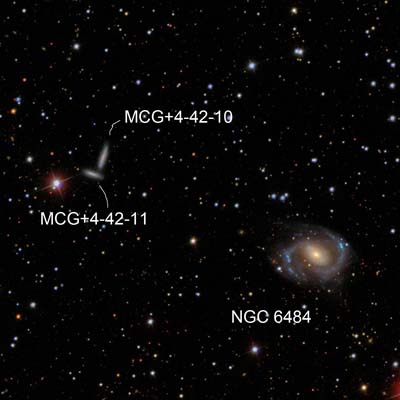 NGC 6484 trio KTG 67
NGC 6484 trio KTG 67
22
(230
and 383x) This trio contains on bright barred spiral
on the west end with two very faint elongated galaxies
close together on the east end.
NGC 6484 17 51
46.9 +24
29 04 1.9x1.6 13.1p
Considerably bright 2:1 elongated glow with defined
edges with a much brighter center. With averted
vision, an extremely faint halo doubles in size. The bright
part is just the center part and the halo is roughly
round. PA
of the core is 60 degrees and 0.7 long. The halo
extends 1.2 across.
MCG+4-42-10 17 52
10.3 +24
31 25 0.7x0.2 14.7
Very faint 3:1 elongated glow with diffuse edges. Even surface
brightness. PA
= 150 and 0.3 long.
MCG+4-42-11 17 52
11.4 +24
31 01 0.6x0.2 15.2
Very faint 2:1 elongated glow with diffuse edges. Even surface
brightness. PA
= 75 and 0.2 long.
A mag 10.8 star lies 1 ESE.
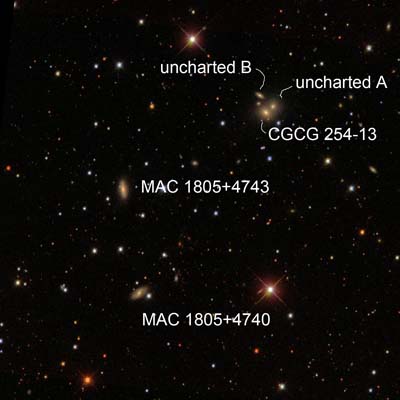
CGCG 254-13
trio
22
(230
and 383x) Very compact trio of faint galaxies arranged
in a narrow isosceles triangle of about .6 long. Lies
in a star rich field.
CGCG 254-13 18 04
48.3 +47
45 25 0.5x0.5 15.6
Considerably faint round diffuse glow. Even surface
brightess. 0.2
across.
Uncharted A 18 04
47.2 +47
45 33 -Very
faint
small round glow. Even
surface brightness.
0.1 across.
Lies 0.2 NW from CGCG 254-13
Uncharted B 18 04
49.2 +47
45 51 -
Extremely faint very small round glow. 0.1 across. 0.4 NNE from
CGCG 254-13
Two
nearby
galaxies:
MAC 1805+4743 18 05
09.4 +47
43 31 0.4x0.2 16.0
Faint 5:2 elongated glow with defined edges. Even surface
brightness 0.3
long and PA = 0 degrees.
Lies 4.1 ESE of trio
MAC 1805-4740 18 05
06.8 +47
40 58 0.4x0.3 16.0
Very faint round even surface brightness glow. A mag 14.3
star is just off the SW tip
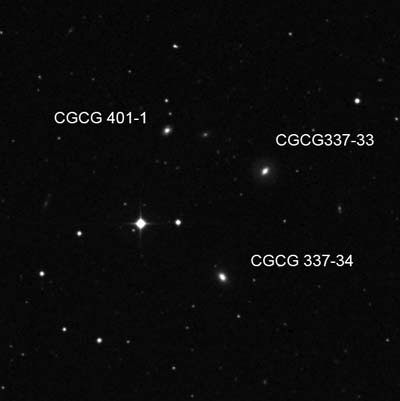 CGCG 337-33 trio KTG 59
CGCG 337-33 trio KTG 59
22
(230
and 383x) This is a really nice trio that is arranged
like a box with a 9.2 mag star. The sides
range from 2.3 to 3.0.
CGCG 337-33 15 15
36.0 +69
18 56 1.1x1.1 15.0
Considerably bright round glow with a much brighter
center. Defined
edges. 0.2
across.
CGCG 337-34 15 15
50.5 +69
16 25 0.3x0.2 15.2
Considerably faint round glow with a stellar core. Defined edges. 0.2 across
CGCG 401-1 15 16
02.5 +69
20 10 0.3x0.2 15.7
Faint round glow with diffuse edges. Even surface
brightness 0.1 across.
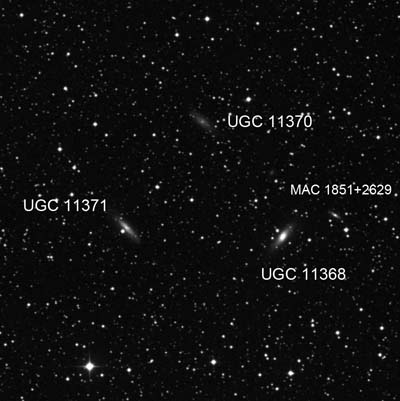 UGC 11368 trio KTG 68
UGC 11368 trio KTG 68
22
(230
and 383x) A trio of elongated galaxies in a very rich
star field.
UGC 11368 18 51
29.9 +26
29 01 1.3x0.4 14.3p
Considerably bright 2:1 elongated glow with a much
brighter slightly elongated nucleus. 0.5x0.3 and
PA = 135 degrees. A
pair of 13 and 14th magnitude stars lies just
off the NE edge and a 16th mag star lies just
off the SW edge. I
didnt look for the nearby galaxy, MAC 1851+2629.
UGC 11370 18 51
43.6 +26
33 19 1.2x0.4 14.6p
Extremely faint, 2:1 elongated glow with diffuse
edges. Very
low and even surface brightness. 0.3 long. And
PA = 45 degrees. Lies
5.3 NE from UGC 11368.
A mag 11.6 star lies 1.9 NW.
UGC 11371 18 51
56.0 +26
29 14 1.6x0.5 14.3p
Very faint 3:1 elongated even surface brightness glow
with diffuse edges.
PA = 45 degrees and 0.5x0.2 A mag 12.2
star lies just off the SE edge in the center.
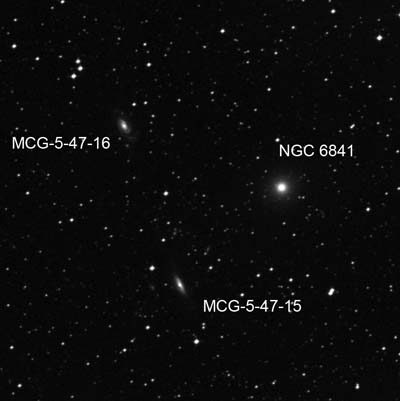 NGC 6841 trio
NGC 6841 trio
22
(230
and 383x) Trio of galaxies in Sagittarius,
surprisingly in a not so rich star field. Arranged in a
loose 45 degree right triangle.
NGC 6841 19 57
49.0 -31
48 37 1.3x1.3 13.8b
Considerably bright round glow with a brighter center. Diffuse edges. 0.6 across.
MCG-5-47-15 19 58
07.0 -31
52 16 1.1x0.3 15.1p
Faint 3:1 elongated even surface brightness glow. 0.6x02 and PA = 30
degrees. Lies
5.3 SE of NGC 6841
MCG-5-47-16 19 58
16.9 -31
46 18 1.4x0.9 14.5p
Faint 3:2 elongated even surface brightness glow with
diffuse edges. PA
= 30 and 0.6x0.3.
Located 6.5 ENE of NGC 6841.
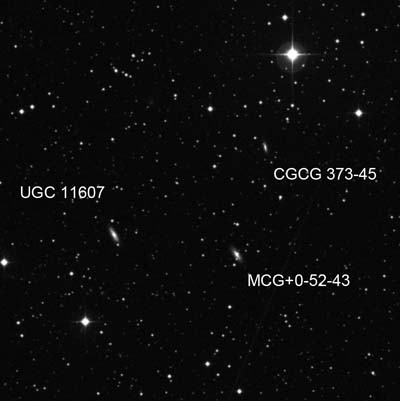 UGC 11607 trio KTG 70
UGC 11607 trio KTG 70
22
(230
and 383x) A 45-degree right triangle of elongated
galaxies flanked by two bright mag 7.7 and 9.5 stars on
each side. It
lies in a fairly rich star field.
UGC 11607 20 39
44.7 +02
01 51 0.8x0.2 14.9p
Considerably faint 3:1 elongated glow with a stellar
core in the center.
Even surface brightness. Edges are
pretty well defined.
PA = 30 degrees and the size is 0.6x0.3. A mag 9.5 star
lies 3.5 SSE.
MCG+0-52-43 20 39
26.4 +02
01 07 0.8x0.3 15.2
Considerably bright 2:1 elongated even surface
brightness glow with a slightly brighter center. Defined edges. 0.5x0.3 and
PA = 30 degrees. 4.6
WSW from UGC 11607.
CGCG 373-45 20 39
22.1 +02
05 09 0.5x0.1 15.2
Faint 3:1 elongated glow with diffuse edges. 0.3x0.15 and
PA = 15 degrees. A
mag 7.7 star lies 3.6 NNW.
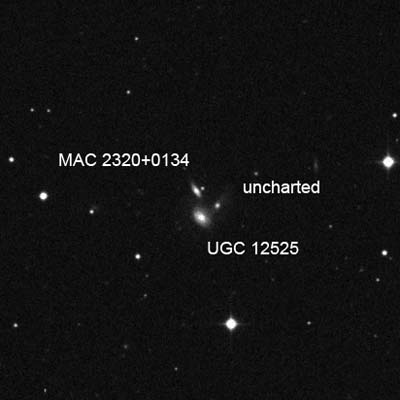 UGC 12525 trio
UGC 12525 trio
22
(230,
383 and 690x) Very challenging compact trio of
galaxies that occupies a space of less than 40 in
diameter. The
uncharted member was not detected.
UGC 12525 23 20
26.8 +01
33 37 0.7x0.5 15.1
Considerably faint 3:2 elongated glow with a slightly
brighter center. 0.2
long and PA = 30 degrees
MAC 2320+0134 23 20
27.0 +01
34 04 0.4x0.1 16.0
Faint round even surface brightness glow. 0.1 across. 0.5 due
north of UGC 12525
Uncharted 23 20
25.5 +01
33 51 0.1 mag = ? - not
detected.
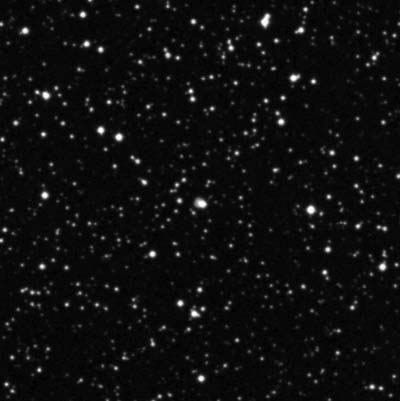 Little Blue Fox 20 29
07.5 +23
11 12
Little Blue Fox 20 29
07.5 +23
11 12
22 (93, 230 and
383x) The extended nebulosity is detected with a NPB,
Ultrablock or O-III filter. Not
immediately noticed as I initially used a low power, but
bumping it to 230x, it was obvious, even without a
filter. At
383x the slightly elongated glow was noticed and the
central star is slightly off-centered to the west. PA = 80
degrees and 0.3 across.
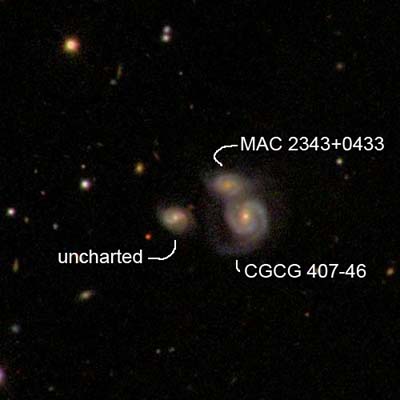 CGCG 407-46 trio
CGCG 407-46 trio
22
(230,
383 and 690x) Very compact 30-60-right triangle with
the long side of just 40 long.
CGCG 407-46 23 43
17.0 +04
33 04 0.5x0.4 15.4
Very faint small round glow. 0.3 across. Diffuse edges.
MAC 2343+0433 23 43
17.7 +04
33 21 0.3x0.2 16.0
Very faint small round glow. 0.1 across. 0.3 NNE of
CGCG 407-46
Uncharted 23 43
19.3 +04
33 03 0.2x0.2 NED mag =
16.5
Extremely faint very small round glow that is best at
690x. Popped
in and out 25% of the time. 0.1 across. 38 due east
of CGCG 407-46.
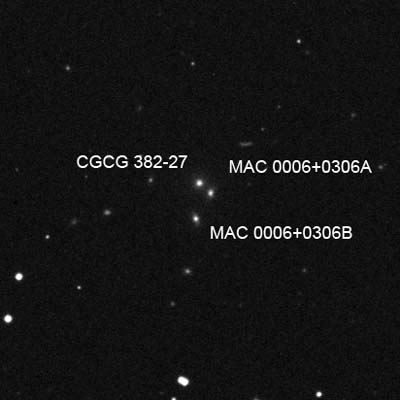 CGCG 382-27 trio
CGCG 382-27 trio
22
(230,
383 and 690x) Another compact 30-60-right triangle
occupying a space of less than 40 circle. All three
galaxies are about equal brightness and best seen at
690x.
CGCG 382-27 00 06
57.0 +03
06 47 0.3x0.2 15.5
Very faint small round glow. 0.1 across.
MAC
0006+0306A
00 06 56.2
+03 06 37
0.3x0.2
16.0
Very faint small round glow. 0.1 across. Very slightly
fainter than CGCG 382-27, which is 18 NE.
MAC
0006+0306B
00 06 57.3
+03 06 10
0.4x0.2
16.0
Very faint small round glow. 0.1 across. Slightly
fainter than MAC 006+0306A, which is 35 NNW.
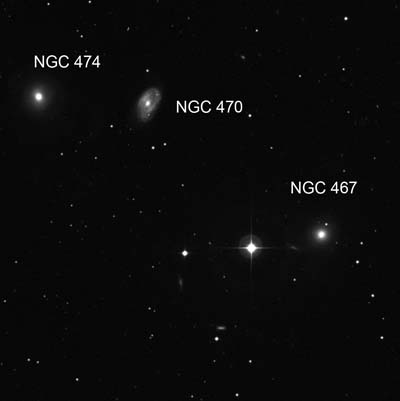 NGC 467 trio KTG 05
NGC 467 trio KTG 05
22
(230x)
Three bright galaxies in a fairly loose arrangement
with a bright mag 7.1 star in the field.
NGC 467 01 19
10.1 +03
18 02 1.6x1.5 12.9b
Bright round glow with a brighter round center. Diffuse edges. 0.8 across. A mag 14.1
star lies just off the NNW edge.
NGC 470 01 19
44.8 +03
24 36 2.8x1.7 12.5b
Bright mottle glow with a much brighter small center. 1.7x1.0
across and PA = 150 degrees.
NGC 474 01 20
06.8 +03
25 00 7.0x6.2 12.4b
Bright glow with a much brighter center. Very diffuse
edges. 1.4
across and the nucleus is 0.3 across.
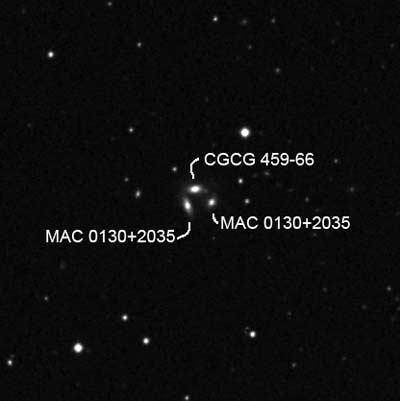 CGCG 459-66 trio
CGCG 459-66 trio
22
(230,
383 and 690x) Very compact of faint galaxies occupying
a space of about 0.5 across.
CGCG 459-66 01 30
16.3 +20
35 59 0.4x0.2 14.9
(NED mag = 14.10)
Considerably faint round glow with diffuse edges. 0.1 across.
MAC 0130+2035 01 30
15.4 +20
35 46 0.3x0.2 16.5
(NED mag = 16.02)
Very faint round glow with diffuse edges. 0.1 across.
Uncharted 01 30
16.9 +20
35 43 0.3x0.2 NED mag
16.64
Very faint round glow with diffuse edges. 0.1 across.
Back to Observing Reports
All Observing Reports are copyrighted by Alvin Huey. You can print them for personal use only.
Components Aids Guides Observing Guides Reports
